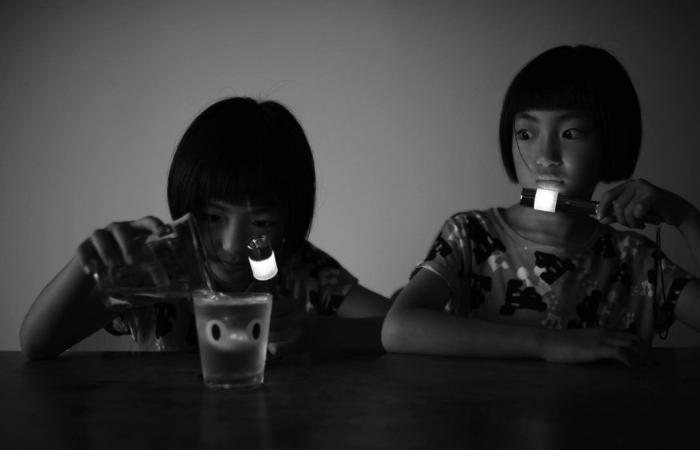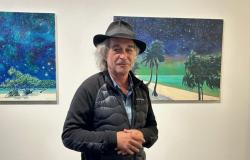The Japanese fair T3 Photo Fair Asia held its first edition from Friday October 18 to Monday October 21. In the vast Midtown Yaesu space, it brought together Japanese and Korean galleries, before opening next year to other historical scenes emerging from the Asian continent.
Walking through a fair remains a subjective exercise. Whether we are a collector or a great lover, we go from gallery to artist, from artist to work as we would jump in a festival from one stage to another, our ears wide open, our minds strained for the horizon discoveries. To echo it is necessarily to frustrate some, to praise others, to fall in love in short, and to remain blind to others.
Hiroshi Nomura at the Poetic Scape gallery (Tokyo)
The “Doppelopment” series by Hiroshi Nomura (Japan) is named after the contraction of two words (Doppelgänger which designates a hallucination of oneself in another and development in English which recalls the idea of growth like photographic technique). Double optionthis trumped-up word is, at first glance, anything but scholarly in Hiroshi Nomura’s work.
The series exhibited by the Tokyo gallery Poetic Scape shows two twins in everyday scenes: sometimes playing on the ground, other times both immersed in exploration, a flashlight in hand. Back to back as if to invite you to play the game of seven differences. Posing right on the street. One concentratedly playing the piano, the other mischievous, pulling a grimace. In short, banal scenes, captured by Nomura in great simplicity, and which the double presence of the binoculars makes slightly strange.
These twins, all joy and simplicity, full of love, would be the opposite of the disturbing memory of the bloody sisters of Shining. But what perhaps links them to Kubrick, and even more to the constant lie of photography, is that there are two in the image, and one in reality.
Through the game of double exposure, in a clever assemblage, absolutely exquisite to detect (if one knows how to do it, which I cannot), Hiroshi Nomura had fun with his daughter Hana composing his artificial scenes, playing towards Diane Arbus or even Shigeo Gocho. It is an admirable work of tenderness, exquisite in its lie.
John Yuyi, secteur Emergence : « Discover New Asia: Exploring Artistic Self-Discovery with Four Women »
John Yuyi, whose name is Chiang Yu-Yi (Taiwan), is one of the stars of today’s fashion photography. Its brilliance was revealed by its “Becoming Famous” series, with its faces of celebrities tattooed with stickers, then in its sequel with the “Face Post” series, this time with faces marked with slogans and other saturation advertising messages.
No saturation, no abundance in the four prints shown in the short but well thought-out sequence dedicated to Asian artists of the “new Asia”. But a large sibylline blue sky which unites the whole and a naked body in the foreground, divided into three pieces; head, chest and buttock with in the background, blurred silhouettes, naked bodies which follow the body in the foreground as would walkers on the side of a hill. We don’t know why, everything gives this impression of lightness, of joy, of eroticism without consequence, without even desire, other than the gesture of liberation.
Limb Eung Sik, “Masters selection” and at the Yeh Gallery (Seoul)
Born in Japan in 1912 and died in South Korea in 2001, Limb Eung Sik embodies the tormented history between his two countries through his images and his photojournalistic approach. He is today considered a major figure in Korean photographic history. Rightly so since he helped bring Edward Steichen’s exhibition “The Family of Man” to the National Museum of Modern and Contemporary Art in Seoul in 1957 (The exhibition brought together more than 300,000 people !).
Initially a salon and portrait photographer, he became a field photographer during the Korean War (1950-1953). His images adopt a form of realism which combines the humanist influences of Cartier-Bresson. His works are present in two places in the fair: first very widely by the Korean gallery Yeh as well as in a presentation designed by the director of the fair, Jeong Eun Kim.
Kijuki Kawada, Photo Gallery International (PGI) (Tokyo)
Photo Gallery International is one of the emblematic galleries of this fair. Alongside Emet Gowin, Edward Weston and Harry Calahan, she defends the great Japanese masters like Yasuhiro Ishimoto and Kijuki Kawada. The latter, founder of the VIVO collective in 1959 with Akira Sato, Akira Tanno, Shomei Tomatsu, Ikko Narahara and Eikoh Hosoe. His saturated, mostly dark works contrast with a print of great light, a female body rising to the surface of a swimming pool. Like a salvation in a work tormented as clairvoyant.
Hideka Tonomura, Zen Foto Gallery (Tokyo)
The Arles public met Hideka Tonomura (Japan) this summer during the “Transcendence” exhibition, in the labyrinth of the Vague house. His installation remained, in my opinion, the dazzling work of this myriad exhibition, his small color prints an installation full of gravity, unvarnished in its way of showing the body, commodified sexuality, the sorrows of everyday life, the wanderings specific to each person. His somewhat elusive style, made of filters, strong colors, flesh or blood colors, otherwise a medical blue, and his distance from the subject through movement and blur give his works a general impression of a great whirlwind. The recent works shown by the Zen Foto gallery are in this vein, always with the same sticky charm.
More information:






